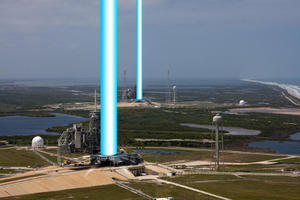Shape of things to comeBeaming rockets into space
Space launches have evoked the same image for decades: bright orange flames exploding beneath a rocket as it lifts, hovers, and takes off into the sky; an alternative propulsion system proposed by some researchers could change that vision; instead of explosive chemical reactions on-board a rocket, the new concept, called beamed thermal propulsion, involves propelling a rocket by shining laser light or microwaves at it from the ground; with the beam shining on the vehicle continually, it would take eight to ten minutes for a laser to put a craft into orbit, while microwaves would do the trick in three to four minutes

Lower cost rocket lauching with lasers // Source: good.is
Space launches have evoked the same image for decades: bright orange flames exploding beneath a rocket as it lifts, hovers, and takes off into the sky.
An alternative propulsion system proposed by some researchers could change that vision.
Instead of explosive chemical reactions on-board a rocket, the new concept, called beamed thermal propulsion, involves propelling a rocket by shining laser light or microwaves at it from the ground. The technology would make possible a reusable single-stage rocket that has two to five times more payload space than conventional rockets, which would cut the cost of sending payloads into low-Earth orbit.
Astrobiology Magazine reports that NASA is now conducting a study to examine the possibility of using beamed energy propulsion for space launches. The study is expected to conclude by March 2011.
In a traditional chemical rocket propulsion system, fuel and oxidizer are pumped into the combustion chamber under high pressure and burnt, which creates exhaust gases that are ejected down from a nozzle at high velocity, thrusting the rocket upwards.
A beamed thermal propulsion system would involve focusing microwave or laser beams on a heat exchanger aboard the rocket. The heat exchanger would transfer the radiation’s energy to the liquid propellant, most likely hydrogen, converting it into a hot gas that is pushed out of the nozzle.
“The basic idea is to build rockets that leave their energy source on the ground,” says Jordin Kare, president of Kare Technical Consulting, who developed the laser thermal launch system concept in 1991. “You transmit the energy from the ground to the vehicle.”
With the beam shining on the vehicle continually, it would take eight to ten minutes for a laser to put a craft into orbit, while microwaves would do the trick in three to four minutes. The vehicle would have to be designed without shiny surfaces that could reflect dangerous beams, and aircraft and satellites would have to be kept out of the beam’s path. Any launch system would be built in high-altitude desert areas, so danger to wildlife shouldn’t be a concern, Kare says.
Thermal propulsion vehicles would be safer than chemical rockets since they can not explode and do not drop off pieces as they fly. They are also smaller and lighter because most of the complexity is on the ground, which makes them easier and cheaper to launch.
“People can launch small satellites for education, science experiments, engineering tests, etc. whenever they want, instead of having to
